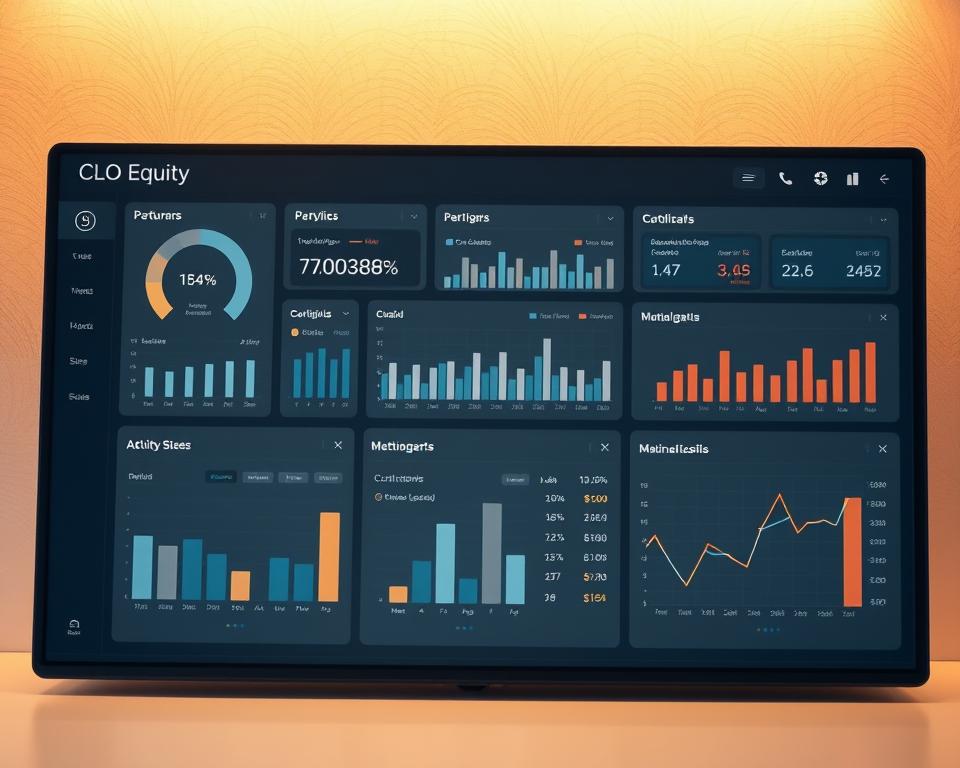Monitor Your CLO Equity Operation Effectively
Have you discovered that CLOs within the United States have expanded into an immense $1.1 trillion domain? This growth is not merely a matter of figures. It mirrors the financial market’s complexity and CLO equity’s evolving role for participants like big pension schemes and family offices. The emergence of advanced investors in CLOs reinforces the importance of mastering CLO capital results monitoring.
Investing in CLO capital investments offers multiple benefits, captivating a broad spectrum of stakeholders. The prospect of elevated returns and consistent cash payouts render CLO funds a worthwhile component to multifaceted portfolios. This singular value proposition reinforces their attractiveness. Investors are captivated by CLO capital for its elevated yield prospects, often aiming for returns in the mid-teens, comparable with private equity’s typical returns. This allure persists, in spite of variable interest rates and market fluctuations. CLOs, with their 150 to 200 diverse holdings, offer a measure of stability infrequent in concentrated portfolios. I intend to supply you with the critical metrics and insights for CLO equity performance, assisting in making savvy investment choices.
Comprehending CLOs: A Thorough Synopsis
Collateralized loan obligations (CLOs) are intricate financial tools. They consolidate various leveraged loans, selling them in slices to investors. Understanding CLOs is vital as they offer corporate financing solutions. Over three and a half decades, their development has radically transformed investment strategies for organizations. This section offers an understanding of the CLO market’s historical evolution and current trends. It spotlights important patterns and features influencing participants.
What is a CLO?
CLOs present a novel method for handling leveraged loans. They combine more than 200 below-investment-grade, well-secured corporate loans. This strategy aims to minimize risk while producing attractive yields. The United States CLO market has been flourishing, now exceeding $1 trillion (March 2024). Growth has been approximately 10% annually since 2012. Despite a slowdown in growth to about 6% in 2023, a minor decline to 1% is anticipated in early 2024. Notably, the prime segments, AAA and AA, have maintained default-free status, highlighting CLOs’ steadiness.
The Expansion and Development of CLOs Over Time
The journey of CLOs is notably marked by their sturdiness during economic downturns. The financial crisis proved this sturdiness; CLOs sustained strong credit standing with low default rates, compared to corporate bonds. Having fallen to $263 billion after the crisis, the market bounced back impressively. By September 2023, it climbed to $970 billion. This growth showcases their trustworthiness in today’s CLO market environment.
New techniques, like CLO ETFs, have propelled the market even further. It’s now worth $15 billion, thanks to increased trading and liquidity. In the United States, a new CLO deal averages around $500 million. In Europe, deals are somewhat smaller, usually €400 million. The majority, sixty to sixty-five percent, goes to senior tiers. Equity tranches comprise about approximately 9 to 10%.
From grasping CLO basics to grasping their progress and modern trends, it’s evident they’re crucial in financial markets. They notably reconcile risk against return for investors.
The Allure of CLO Share Investments
Allocating funds to CLO share investments offers numerous advantages, attracting a diverse array of investors. The potential for high returns and steady cash disbursements render CLO funds a worthwhile component to varied portfolios. This unique value proposition reinforces their allure.
Key Benefits for Participants
CLO equity distinguishes itself for its potential double-digit returns. Forecasts suggest returns of low to mid-teens returns. Steady cash payouts further enhance the attraction of CLO mutual funds, notably for income seekers. Additionally, strong market fundamentals, like low default rates, increase confidence in these investments.
Historically, CLO equity has had lower default rates than standard debt products. Despite potential financial stress in certain segments, expected default rates should remain low. In recessionary periods, high loan spreads can benefit CLO participants. This permits prudent credit selection to mitigate potential losses.
CLO Equity vs. Other Asset Classes
Evaluating CLO equity against alternative investments highlights its distinct advantages. It delivers higher liquidity than private equity funds without sacrificing returns. Although spread compression has occurred, CLOs continue to produce higher returns than debt of similar ratings, demonstrating its allure.
| Investment Category | Gains | Default Rates | Liquidity |
|---|---|---|---|
| CLO Equity | Low to Mid-Digit Returns | Less than traditional debt | Moderate; less liquid than Treasuries |
| Private Equity | Varies; typically lower liquidity | Dependent on the market cycle | Low; often illiquid |
| High Return Bonds | Above Treasury yields | Higher default rates than CLOs | High; more liquid |
The demand for CLOs remains strong, suggesting an optimistic forecast for 2024. Appealing funding expenses, thanks to a beneficial spread balance, boost this opportunity. For those maneuvering through the volatile market, an insight into CLO equity can be vital for effective strategy development.

Assessing CLO Equity Performance: Indicators and Instruments
For investors focused on maximizing returns, precise monitoring of CLO equity performance is vital in the complex financial arena. Efficient employment of CLO equity performance metrics significantly boosts investment approaches. Grasping core KPIs, such as cash flow distributions, NAV, and cost ratios is critical. They provide deep insights into the functional efficiency of CLO investments.
Key Performance Indicators (KPIs) for CLO Equity
CLO equity holders monitor multiple performance indicators to efficiently assess performance. Key metrics include:
- Internal Return Rate (IRR): This indicator is crucial for evaluating long-term gains.
- Cash Yield: Offers insights into how cash distributions compare to invested capital.
- Net Value of Assets (NAV): Represents the valuation of a company’s assets, essential for assessing CLO worth.
- Distribution Rate: Usually approximates 50% of cash flows from assets.
- Default Rates: Historically range between 2% and 3%, with an average 70% recovery rate for defaulted loans.
Optimally Employing Tracking Mechanisms
For successful management of CLO equity investments, which represent in excess of $600 billion worldwide, efficient tracking mechanisms are crucial. Firms such as Flat Rock Global offer specialized tools for CLO equity performance tracking. These instruments enable stakeholders to continually track their portfolios.
These tools assist in analyzing trends in key indicators and setting benchmarks with indices like the J.P. Morgan CLO Index. They also facilitate comparisons with comprehensive indices such as the Bloomberg Aggregate Bond Index and the BofA US Corporate Index by ICE.
Formulating decisions to maximize CLO equity performance becomes achievable for investors leveraging these metrics and tools. This understanding and effective utilization lay the foundation for successful CLO management strategies.
Market Dynamics Shaping CLO Equity Performance
Exploring the collateralized loan obligation funds market trends needs a thorough analysis of the economic setting and its effect on investments. Expansion metrics indicate a vigorous market, providing critical insights to investors. By November 2024, U.S. CLO issuances hit $191 billion, a 72% increase compared to the previous year. This underscores an increasing fascination with CLOs amidst economic shifts.
Current Market Conditions
CLO total volume has escalated to $465 billion, exceeding the 2021 peak of $438 billion. October 2024 saw $59 billion, and November followed with $26 billion, ranking as its second-best. The market expanded 1% since the year’s start, reaching a total of $1.046 trillion. Additionally, the increase in private credit CLOs (PCLOs) with a $36 billion new issuance, set a new record.
Influence of Interest Rates on CLO Share Performance
Rising interest rates significantly impact CLO equity, largely owing to their adjustable-rate characteristic. This makes CLO investments increasingly appealing for investors in pursuit of greater yields in a variable market. Estimates imply CLO issuances in 2025 could be between $180 billion and $215 billion, propelled by supportive elements. It is essential for CLO stakeholders to observe the default rate, which improved from 3.3% in January 2024 to 3.1% at the end of Q1. This evolving scene provides a chance to fine-tune portfolios amidst current CLO equity market movements.
Active Management Strategies for CLO Equity
Overseeing CLO equity investments necessitates proactive management. Via tactical market maneuvering, CLO equity managers seek to enhance yields while reducing risks. These managers understand the complexities of the market. This knowledge significantly influences the success of stakeholders’ investments.
How Managers Drive Performance
CLO equity managers are pivotal in enhancing portfolio output. They monitor the quality and pricing of credit. With this insight, they seize market opportunities. Such diligence facilitates rapid responses to market shifts, maximizing CLO equity distributions. Low default incidences and minimal correlation with risky assets, such as the average US corporate 5-year cumulative default rate demonstrate CLOs’ investment appeal.
Risk Mitigation Techniques in CLO Management
CLO equity managers utilize various strategies to guard against financial risks. These strategies are vital for protecting investors during volatile market periods. They emphasize the difference between asset spreads and debt costs to maximize cash flows. The diverse internal rates of return (IRRs) in CLO equity, with top quartiles reaching up to 25% and bottom quartiles sometimes falling below 0%, show the importance of these risk mitigation techniques’ value in maintaining investment stability through market changes.
Importance of CLO Indices and Comparative Benchmarks
Understanding the role of the CLO index is crucial for making informed equity investment choices. It acts as a barometer for CLO equity, mirroring market trends and influencing investor tactics. By examining these indices, we obtain detailed insights into CLO metrics. This helps us compare risk and trend patterns across distinct asset categories effectively.
Interpreting CLO Index Results
The size of the CLO market has expanded to an impressive $1.2 trillion. It now satisfies about 70% of the demand for US corporate loans. Such growth emphasizes the necessity for dependable benchmarks. Here, CLO indices serve a key purpose. They measure a wide range of performance indicators, allowing investors to assess how their investments fare against the market’s broader scope.
Comparing with Other Market Indices
Comparing CLO performance with other indices sheds light on its positioning. Commonly, CLO equity maintains a roughly 90% debt and 10% equity structure. Concerning safety, AAA tranches record an almost non-existent default rate. This is in sharp contrast to the prolonged average default rates seen in U.S. corporations. Hence, CLOs stand out for their appealing returns and exceptional stability within fixed-income assets.
Moreover, CLO performance metrics often point to a spread benefit over traditional bonds, particularly in the high-yield sectors. This translates into higher potential gains for investors in addition to significant diversification benefits. CLOs maintain a reduced correlation with other high-yield bonds and equities, enabling smarter CLO market positioning and more insightful investment strategy development.
Obstacles in Overseeing CLO Share Performance
Monitoring CLO equity performance is especially demanding, especially when markets are volatile. Investors encounter complexities due to market variability that impact investment risk assessments and opportunity identifications. These variations can dramatically affect default risks and buying choices. Therefore, implementing robust strategies is critical to maintain optimal CLO performance.
Effects of Market Instability
The outlook for the bond market suggests that fixed income stakeholders are moving towards dynamic management strategies. This shift seeks to better accommodate persistent market turbulence, boosting performance in fixed income portfolios. We are in a developing credit cycle, still below its peak, indicating sustained credit portfolio prospects up to 2025. With interest rates high, the challenges in monitoring CLOs become evident, elevating capital costs for CLO equity and underscoring the need for judicious management.
Grasping Default Risk in CLO Assets
It is essential to understand the risk of default in CLO investments for proper monitoring. Evidence suggests that during recessions, CLO loan default rates could hit 3%, detrimentally influencing performance. The combination of elevated interest rates and reduced returns across various investment strategies adds to the complexity. Notably, about 40% of CLO managers are now leveraging advanced analytics and AI to enhance their monitoring, addressing transparency challenges and refining performance evaluations. The complexity of the assets underneath and ongoing regulatory changes pose further obstacles in efficiently managing CLO equity performance.
Forthcoming Prospects for CLO Share Investments
The landscape of collateralized debt obligations is witnessing a transformation. This development points towards a future for CLO equity investments marked by promise and complexity. Insights into market trends highlight considerable opportunities arising from variations in supply, demand, and interest rates. A significant leap in new issuances in 2024, totaling $199.8 billion indicates a strong rebound. This value is 72% greater than that of 2023 and breaks previous records, solidifying the position of CLO equity in the investment domain.
Historic refinancing and reset operations, totaling $309.1 billion in 2024, reinforce investor trust in CLOs. This signals optimistic possibilities, notably for participants poised to manage shifting market trends.
Prospective Advantages in Today’s Environment
With regulatory modifications like Basel III on the horizon, an estimated $190 billion could enrich the market. These regulatory shifts are designed to enhance the attractiveness of AAA, AA, and single-A CLO tranches, forecasted to result in increased demand. CLOs continue to offer attractive total returns, particularly among lower-rated categories. This showcases their impressive performance and the risk-adjusted rewards they carry.
Predicted Trends and Changes to Watch For
Various anticipated adjustments in CLO investment merit consideration. The potential for narrower spreads and improved liquidity looms, shaping investment strategies. The historical resilience against defaults positions CLO equity as a relatively secure investment in uncertain markets. With vigorous issuance forecast for 2025, savvy investors ready to revise their strategies could realize significant returns amid changing conditions. Investors should vigilantly monitor secondary equity positions for attractive cash-on-cash yields.
The Final Word
To sum up, effectively tracking CLO equity performance is crucial for investors entering this distinct asset class. Considering the CLO market’s current valuation exceeds $1.1 trillion, where CLO equity accounts for approximately $100 billion, it’s clear. These investments offer strategic advantages not to be overlooked.
Active management’s importance in boosting CLO performance during critical reinvestment phases cannot be overstated. Given the CLO market’s fluctuations—including interest rates, market conditions, and deal timings, it’s vital that investors keep abreast and act proactively. This strategy allows for adaptive approaches to optimize CLO investment opportunities.
For savvy investors, diving into CLO equity opens up remarkable career possibilities. The mix of diversification benefits and the chance for significant returns showcases CLO equity as a vital part of diversified portfolios. Anticipating the future, staying current with market trends and actively participating in the CLO arena promises significant gains. This underscores the value of a meticulous CLO investment strategy.
FAQ
What is a CLO?
CLOs, also known as collateralized loan obligations, combine various leveraged loans. These are then sold in segments to investors, presenting a distinctive method for participating in corporate finance.
Why invest in CLO equity?
Investing in CLO equity provides significant advantages, including the potential for high yields and consistent distributions. Furthermore, they tend to have low correlation with other asset classes and allow for performance enhancements via adept management.
How can one monitor CLO equity performance?
To monitor CLO equity, focus on key performance indicators. These include cash flow distributions, net asset value, and expense ratios. Investors also benefit from tracking tools from companies like Flat Rock Global.
What current market trends affect CLO equity performance?
Market trends, notably interest rate shifts and economic dynamics, greatly impact CLO equity outcomes. CLO investments can yield higher income as interest rates rise, given their floating-rate nature.
How do CLO managers enhance equity returns?
Through adept trading and rigorous risk management, CLO managers enhance returns by focusing on the credit quality and pricing of loans while swiftly adapting to market fluctuations.
What is the significance of CLO indices in performance evaluation?
CLO indices serve as essential benchmarks that allow investors to gauge CLO equity performance relative to the broader market, thereby illuminating risk and return profiles.
What are the difficulties in monitoring CLO equity performance?
Navigating market volatility poses challenges for investors. It influences the assessment of default risks and the timing for purchasing opportunities. Thus, investors must continuously scrutinize the underlying loans.
What does the future outlook for CLO equity investments look like?
Prospects for CLO equity investments appear promising, with an evolving market environment and anticipated interest rate changes offering potential for strategy refinement.


